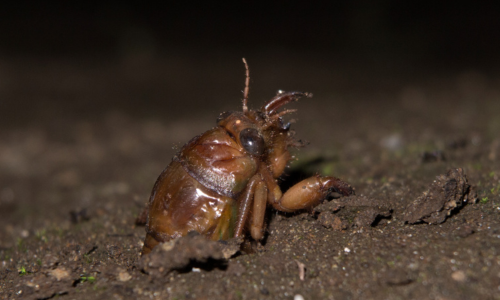Updated on September 30, 2025
- Cicada larvae (nymphs) live underground 2–17 years, feeding on root xylem.
- They usually stay within the top ~2 feet of soil (rarely deeper).
- Mass emergence often starts when soil at ~8 inches reaches ~64°F (18°C).
- They don't bite or sting and rarely harm healthy trees.
- Their tunnels aerate soil and post-emergence carcasses add nitrogen.
Cicada larvae—technically nymphs—spend years underground before a brief, noisy finale above ground.
Quick facts
- Underground stage: 2–17 years
- Typical depth: 0–24 inches (rarely deeper)
- Emergence trigger: ~64°F (18°C) at ~8 inches depth
- Diet: Xylem sap from roots
- Risk to people/pets: None; they don't bite or sting
- Landscape impact: Aeration tunnels; nitrogen pulse from carcasses
What are cicada larvae (nymphs)?

The underground stage of a cicada is technically a nymph—often called a “larva”—that feeds on root xylem for years before emerging to molt into a winged adult. After hatching from eggs laid in tree bark, tiny nymphs drop to the soil, burrow down and attach to fine roots. They’re wingless, compact and equipped with strong digging forelegs to move through soil. They live a secretive existence underground, growing slowly and molting several times, until they tunnel up and shed their nymphal skin at the surface.
Life cycle note: Adult female cicadas lay clusters of eggs totaling hundreds (up to ~600).
How long do cicada larvae live underground?
Most cicada larvae remain underground for 2–17 years, depending on species. Periodical cicadas synchronize in 13- or 17-year broods, creating dramatic, rare mass emergences, while so-called “annual” species still spend multiple years below ground before adults appear each summer.
Cicada larvae in the ground: How deep and when do they emerge?
Cicada larvae typically live in the top 0–24 inches of soil and mass emergence often begins when soil at about 8 inches reaches ~64°F (18°C).
Noticed extra cicadas in 2024? Broods XIII and XIX emerged together—something that occurs about every 221 years.
Depth varies with soil type and where fine roots are most abundant; most activity stays shallow, though there are rare reports of deeper burrows. Warm, moist spring conditions speed their final tunneling to the surface.
Are “cicada grubs” the same thing as cicada larvae?

People often say “grub,” but cicadas aren’t beetles—“grub” usually means beetle larvae; cicada “grubs” are actually cicada nymphs. They can look similar (chunky bodies with strong digging forelegs), but they belong to different insect groups and have different lifecycles and biology.
If you’re noticing large wasps hovering over sandy patches or burrows, those are likely cicada killer wasps—a different insect entirely. Learn how to handle them.
What do cicada tunnels and holes do to soil?
Cicada tunneling leaves porous channels that improve soil structure, water movement and nutrients.
- Aeration: Burrows create pathways that make soils looser and easier for roots to penetrate.
- Water infiltration: Emergence holes act as temporary conduits that let rain reach deeper layers, which can raise soil moisture after big emergences.
- Nutrient pulse: After emergence, shed skins and carcasses decompose, releasing nitrogen and other nutrients that feed soil microbes and plants.
Conclusion
Cicada larvae spend years doing quiet work underground—feeding on roots, shaping soil and setting the stage for a brief burst of summer sound. Understanding when they emerge and what those tunnels do helps homeowners care for their homes and gardens with confidence.
About Dr. Killigan’s
At Dr. Killigan’s, we believe pest management should be effective, eco-minded and respectful of the ecosystems we share. Our guides aim to reduce fear, clear up confusion and help you choose gentle solutions when action is necessary.





















